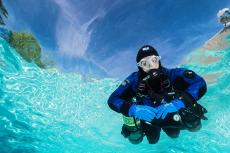Pool Diving Adventure
The Northeast US dive season usually starts with divers dusting off the cobwebs at Dutch Springs in Bethlehem, Pennsylvania. This year, the season started in the middle of a pandemic. Dutch Springs did not open in April, as it does most years. If you are a technical diver that is drying out, what is one to do? In our case, we took our drysuits, rebreathers, camera housings and sidemount rigs to our friend Gregory Borodiansky’s pool.
Tags & Taxonomy
Gregory is a technical diving instructor and teaches a number of different rebreathers. Living in Staten Island, he has a 2m (7ft) deep, heated pool in his backyard. This was the only place for us to get wet! My dive buddy, Olga Torrey, and I had some new or recently repaired gear that needed to get wet and checked out. Olga had a new drysuit from DUI, ordered at DEMA, and a new Hollis Katana 2 sidemount harness that needed to be adjusted. I had a new zipper and leaks fixed in my drysuit.
In addition, I needed to test my new Aquatica housing, for the Olympus OM-D E-M1 Mark II camera, and a Shearwater NERD2 computer. The new gear and repairs were required to prepare for local diving as well as trips to Newfoundland, British Columbia, Philippines and Fiji. But all the trips were postponed, as the world learned to deal with the new normal. Trying to be optimistic, we decided to dive in the pool. This would be a different kind of diving adventure!
The pool was heated to 32°C (90°F). We were dressed in our drysuits, so we could check them for leaks. It was hard to tell if the dampness was coming from outside or inside! In the pool, Gregory was able to get Olga’s sidemount harness adjusted and ready for open water. Olga practiced using a spool and deploying a SMB. This is an important skill to practice at the beginning of the season. Due to possible entanglement risk, do not practice this skill unless properly trained.
Photography
It was a challenge, using a housing on a sunny day, in very clear pool water. In open water, we use the camera’s LCD screen for composition. On a bright day, we had to use the viewfinder. I was able to adjust the near-eye remote display (NERD) computer, so it was not an obstruction to look through the camera’s viewfinder. In the bright light, we had to use a low ISO, fast shutter speed and stop down the aperture, in order to balance the ambient light with our strobes.
Experimenting with different techniques, we were able to use Snell’s window. This is a phenomenon by which an underwater viewer sees everything above the surface through a cone of light. This phenomenon is caused by the refraction of light entering the water (Wikipedia). In the pool, we were able to take advantage of this to create interesting images.
Yana Borodiansky was appropriately dressed for the 32°C (90°F) water to model for Olga. Working close to the surface, Olga photographed Yana swimming, to capture her reflection using the Snell’s window technique.
Rebreather check
Gregory used his pool to check the operation of several different rebreathers, and to test the new chest-mount unit he designed and built off-season. This compact unit weighs only 5.44kg (12lbs) and holds 2.27kg (5lbs) of sorb. Oxygen is injected with a KISS valve, and the oxygen tank could be mounted either under the rebreather or on the diver’s butt under the harness. The dil and bailout tank is sidemounted. Since the counter lungs are in front, near the diver’s lungs, the work of breathing is excellent even when the diver is upside down. This tiny rebreather is perfect for recreational dives by itself or as a bailout rebreather along with a main back or sidemounted unit.
Between the three of us, we used US$30,000.00 worth of gear to dive in 2m (7ft) of water! It was worth every penny! But now that Dutch Springs is open again, we are taking our gear deeper. Soon, we will be doing boat dives up and down the East Coast. We are so looking forward to traveling internationally again. ■
Gregory Borodiansky can be reached at info@scubatron.com.
Larry Cohen and Olga Torrey are well-traveled and published underwater photographers based in New York City, USA. They offer underwater photography courses and presentations to dive shops, clubs and events. For more information, visit: liquidimagesuw.com and fitimage.nyc.
Download the full article ⬇︎




































